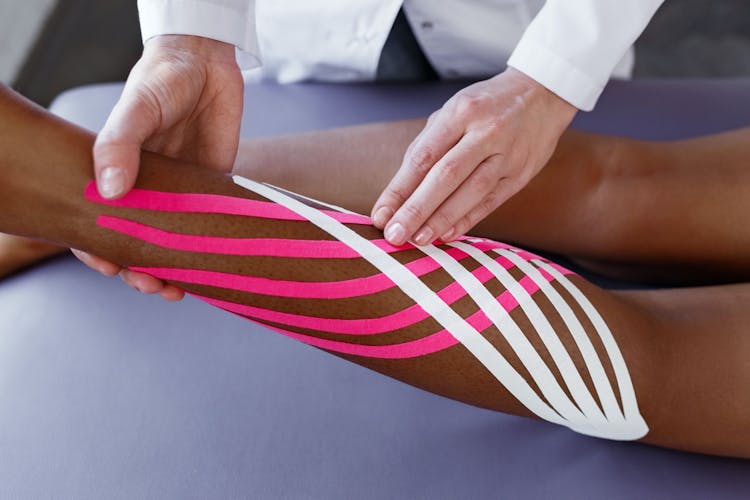Most of you have probably seen athletes with tape attached to various parts of their bodies, like their necks, backs, arms, or legs. It’s an elastic form of tape called Kinesio tape and it’s used to stabilize muscles in a specific area. Although it’s commonly used by athletes, anyone with an injury can use Kinesio Tape to provide some extra support. Being taped still allows you to move, just in a controlled way that gives your muscles and ligaments a chance to heal. Taping around an injury can be a great tool for someone recovering from an injury or trying to train through one.
Keeping Your Injury Stabilized
Kinesio tape can either allow you to move better or restrict movement so you’re comfortable as you’re healing. Applying Kinesio tape to an injured, sprained, or strained area works to stabilize and take pressure off of the injury. That means that if you want to keep moving you can—but you also won’t move enough to put strain on your injury. It can be applied to injuries all over the body, with the most common athletic injuries being around the ankles, knees, shoulders, and even the neck. It’s used as a low level stabilization technique to help get the injured muscle or joint in a more supported position in the body. For example, if you’re getting over an ankle injury and no longer need a brace or boot, Kinesio tape could be applied to the outside of your ankle for additional support. Besides just giving your injury extra support, taping also works by giving your injury a chance to heal. If you’ve hurt your knee, taping around it could take pressure off of the knee joint by helping with support. That way, inflammation in that area is reduced and it gives a chance for the injured area to restore and heal.
Alignment & Support For Your Limbs
Kinesio taping can also be used to align certain joints and muscles to prevent further injury. For example, if you’ve hurt your ankle, you’re putting your knees at risk for getting injured as well since your body is off balance. If you’re working through an injured ankle and feel weakness or wobbliness around the joint, taping the outside of the ankle a specific way will allow it to align better with the rest of your leg. Having correct alignment can also work to decrease pain and help the joints and tightened muscles recover from activities. It also has added neuromuscular benefits simply by making you more aware of your movements and posture. Since you’re injured muscle is Kinesio taped into proper alignment, you’re re-educating your movement patterns.
Find A Taping Expert For Your Needs
With Kinesio taping, it’s key that you go to someone who has a background in kinesiology, anatomy, and physiology to apply taping techniques to injuries. It may look simple, but there are several different taping techniques, combinations, and tension strengths that have to be applied above specific muscles or joints. Taping yourself is also difficult, especially if your injury is in a hard to reach area. If you’ve been injured and are using Kinesio tape in the meantime as you continue with training, keep in mind that you need to get checked out by a medical professional to treat your condition. It’s important to know that Kinesio taping is just another tool in your treatment toolbox when it comes to recovering from an injury. It’s an effective short-term solution that’s used to relieve strain and pain from an area of injury. To completely resolve the source of your pain, Kinesio taping should be in conjunction with a full-fledged treatment program.

